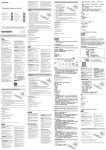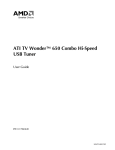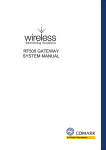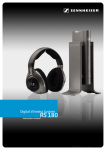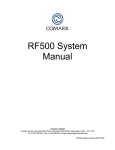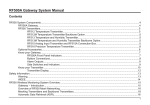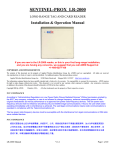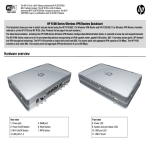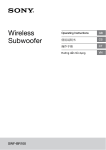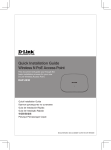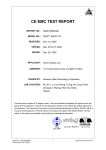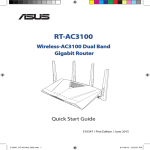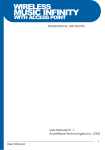Download Sennheiser RS 220
Transcript
Contents Contents Important safety information ........................................................................... 2 The RS 220 digital RF headphone system ...................................................... 4 Delivery includes .................................................................................................. 5 Product overview ................................................................................................. Overview of the headphones ...................................................................... Overview of the transmitter ........................................................................ Overview of the transmitter’s connections .............................................. Overview of the indicators ........................................................................... 6 6 7 7 8 Putting the RS 220 into operation ................................................................... 9 Setting up the transmitter ........................................................................... 9 Connecting the transmitter to audio sources ........................................ 10 Connecting the transmitter to the mains ............................................... 14 Charging the rechargeable batteries inside the headphones ............. 14 Adjusting the headband of the headphones ......................................... 15 Using the RS 220 ............................................................................................... 16 Switching the transmitter on/off ............................................................. 16 Switching the headphones on/off ........................................................... 19 Selecting an audio source or toggling between audio sources .......... 21 Adjusting the volume on the headphones ............................................. 23 Adjusting the balance ................................................................................. 23 Associating a second pair of headphones to the transmitter ............ 24 Cleaning and maintaining the RS 220 ........................................................... 25 Changing the rechargeable batteries of the headphones ................... 25 Replacing the ear pads ............................................................................... 26 If a problem occurs ... ........................................................................................ 27 Specifications ...................................................................................................... 29 Manufacturer declarations ............................................................................... 30 RS 220 | 1 Important safety information Important safety information 왘 Please read this instruction manual carefully and completely before using the product. www RS 220 Manual www.sennheiser.com 왘 Make this instruction manual easily accessible to all users at all times. Always include this instruction manual when passing the product on to third parties. 왘 This instruction manual is also available on the Internet at www.sennheiser.com. Preventing health problems 왘 Before using the product, set the volume to a low level. To protect your hearing, avoid listening at high volume levels for long periods of time. 왘 Do not use the product in situations which require special attention (e.g. in traffic or when performing skilled jobs). The product generates stronger permanent magnetic fields that could cause interference with cardiac pacemakers and implanted defibrillators (ICDs). 왘 Always maintain a distance of at least 3.94” (10 cm) between the ear cup housing and the cardiac pacemaker or implanted defibrillator. Preventing damage to the product 왘 Always keep the product dry and do not expose it to extreme temperatures (normal operating temperatures: 5°C/41°F to 40°C/104°F). 왘 Use the product with care and store it in a clean, dust-free environment. Varnish or furniture polish may degrade the feet of the transmitter, which could stain your furniture. You should therefore place the transmitter on a non-slip pad to avoid potential staining of furniture. 왘 Switch the headphones off after use to conserve battery power. Remove the batteries if the headphones will not be used for extended periods of time. Preventing damage to the power supply unit 왘 To reduce the risk of fire or electric shock, do not expose the product to rain or moisture. 왘 Unplug the mains unit from the wall socket to completely disconnect the product from the mains, during lightning storms or when unused for long periods of time. 왘 Only operate the mains unit from the type of power source specified in the chapter “Specifications”. 왘 To prevent heat accumulation, always ensure that the mains unit is in a safe operating condition and easily accessible, properly plugged into the wall socket and not covered or exposed to direct sunlight for longer periods of time. 왘 Only use the power supply units, charging cables and accessories recommended by Sennheiser. An overview can be found on www.sennheiser.com. 2 | RS 220 Important safety information Intended use Intended use of the product includes • having read this instruction manual, especially the chapter “Important safety information”, • using the product within the operating conditions and limitations described in this instruction manual. “Improper use” means using the product other than as described in this instruction manual, or under operating conditions which differ from those described herein. Safety instructions for the NiMH rechargeable batteries If abused or misused, the rechargeable batteries may leak. In extreme cases, they may even present • • • • a heat hazard, a fire hazard, an explosion hazard, a smoke or gas hazard. Please understand that Sennheiser does not accept liability for damage arising from abuse or misuse. Keep away from children. Only charge the rechargeable batteries in the headphones (see page 14). Observe correct polarity. Pack/store charged batteries so that the terminals cannot contact each other – danger of shorting out/fire hazard. Do not expose to moisture. Switch rechargeable batterypowered products off after use. Only charge rechargeable batteries at ambient temperatures between 10°C/50°F and 40°C/104°F. When not using rechargeable batteries for extended periods of time, charge them regularly (about every 3 months). Do not mutilate or dismantle. Do not heat above 70°C/158°F, e.g. do not expose to sunlight or throw into a fire. Immediately remove rechargeable batteries from an obviously defective product. Do not continue to use defective rechargeable batteries. Only use rechargeable batteries specified by Sennheiser. Dispose of rechargeable batteries at special collection points or return it to your specialist dealer. RS 220 | 3 The RS 220 digital RF headphone system The RS 220 digital RF headphone system Experience audiophile sound quality with the RS 220 digital wireless headphone system. Consisting of a transmitter and open, circum-aural headphones, the system offers uncompressed music enjoyment – just like wired high-end headphones. The rechargeable batteries can conveniently be recharged while in the headphones. Enjoy total freedom of sound, stylish design and maximum comfort. Additional features of the RS 220 RF headphone system • Transmits uncompressed CD-quality audio over a robust 2.4 GHz digital link, enabling you to enjoy your music without the hassles of cables. • Dynamic transducer systems with powerful neodymium magnets deliver clear and detailed audio reproduction. • No set-up required – just plug and play. Simply connect the transmitter to your personal audio/video player, put on the headphones and turn it on. • TR 220 transmitter with multi-receiver capability, enabling up to 2 people to listen to the same audio source via an optional second pair of headphones. • Signals can be looped through so that the transmitter can be integrated into an existing connection between 2 devices • Universal connections: – 1 analog input and output – 1 coaxial digital input and output – 1 optical digital input and output 4 | RS 220 Delivery includes Delivery includes HDR 220 headphones TR 220 transmitter Power supply unit with country adapters Stereo audio cable with dual RCA plugs on each end Coaxial cable with a single RCA plug on each end – for digital connections Audio adapter (2 RCA sockets to 3.5 mm jack plug) BA 200 rechargeable batteries, HR03, AAA size, NiMH RS 220 Digital wireless system Quick Guide Quick Guide Quick Guide Quick Guide Quick Guide Quick Guide Quick Guide Quick Guide Quick Guide Quick Guide Quick Guide Quick Guide Quick Guide Quick Guide Quick Guide Quick Guide incl. CD ROM with detailed instruction manual (PDF file) RS 220 Digital wireless system Safety Guide Safety Guide Consignes de sécurité Indicaciones de seguridad Instruções de segurança Sicherheitshinweise Indicazioni di sicurezza Instruções de segurança Veiligheidsvoorschriften A list of accessories can be found on the RS 220 product page at www.sennheiser.com. For information on suppliers, contact your local Sennheiser partner: www.sennheiser.com > “Service & Support“. RS 220 | 5 Product overview Product overview Overview of the headphones 1 2 2 3 4 3 0 5 9 6 8 7 1 Headband 2 Charging contacts 3 Battery compartments 4 Ear pads 5 Volume +/L button 6 Balance button for changing between Volume/Balance 7 Volume –/R button 8 On/Off button 9 Power LED 0 Input button for selecting the audio source 6 | RS 220 Product overview Overview of the transmitter A I COAXIAL N Pairing OUT OPTICAL DIGITAL -LEVEL H B G C F J D E A Charging contacts for charging F the headphones G B ANALOG LED H C COAXIAL LED I D OPTICAL LED J E Touch key for selecting the audio source Power touch key ON LED Battery LED Pairing button LEVEL control dial Overview of the transmitter’s connections 쐇 쐄 쐋 쐂 쐃 IN 9V/1A OUT R COAXIAL IN OUT L DC IN Pairing OPTICAL ANALOG DIGITAL 쐏 -LEVEL 쐆 쐃 DC IN socket for power supply unit Inputs Outputs 쐇 ANALOG IN (analog) 쐄 ANALOG OUT (analog) 쐋 COAXIAL IN (digital coaxial) 쐂 COAXIAL OUT (digital coaxial) 쐏 OPTICAL IN (digital optical) 쐆 OPTICAL OUT (digital optical) RS 220 | 7 Product overview Overview of the indicators Indicators on the headphones Indicator Status Meaning Power LED 9 lights up blue The headphones have found a suitable transmitter. flashes blue The headphones haven’t found a suitable transmitter. flashes alternately blue and red The headphones are in pairing mode. flashes red The rechargeable batteries are almost flat. off The headphones are switched off. 9 Indicators on the transmitter H B G C Indicator Status ON LED G lights up green The transmitter has found suitable headphones. D Battery LED H Meaning flashes green The transmitter hasn’t found suitable headphones. lights up red The transmitter is in loop through mode (i.e. a digital signal can be looped through to connected devices). off The transmitter is in standby mode. lights up red The rechargeable batteries are being charged. off The rechargeable batteries are fully charged. ANALOG LED B/ lights up green The corresponding input (“IN”) has COAXIAL LED C/ been selected. OPTICAL LED D 8 | RS 220 Putting the RS 220 into operation Putting the RS 220 into operation Setting up the transmitter 왘 Choose a suitable place near your audio source (e.g. TV, stereo or home cinema system). Avoid placing the transmitter close to metal objects such as shelf bars, reinforced concrete walls, etc. as this can decrease the transmitter’s range. It is not necessary that the transmitter and headphones are in the same room, so you can move around freely in the home or outside in the garden. RS 220 | 9 Putting the RS 220 into operation Connecting the transmitter to audio sources You can connect up to 3 audio sources (e.g. CD player, DVD player and TV) to the transmitter. The transmitter is fitted with 2 digital and 1 analog inputs and outputs. If you connect several audio sources, you can conveniently toggle between these audio sources with a key press (see page 21). 왘 Switch your audio source off before connecting the transmitter. 왘 Check the available connection possibilities of your audio source. 왘 Select the corresponding connection cable and, if necessary, a suitable adapter. Connection possibilities (output) of the audio source A RCA (analog) L R Connection cable/adapter Stereo audio cable with dual RCA plugs on each end B SCART (analog) Stereo audio cable with audio adapter (to be ordered separately) C Headphone socket Stereo audio cable with audio adapter D Coaxial (digital) Coaxial cable with with a single RCA plug on each end E Optical (digital) Optical digital cable (to be ordered separately) (analog) 왘 Follow the instructions in the corresponding chapter in order to connect your transmitter to the audio source. A Connecting the transmitter to RCA sockets 쐇 OUT R IN 9V/1A R R COAXIAL IN L L DC IN L OUT Pairing OUT OPTICAL ANALOG DIGITAL -LEVEL K 왘 Connect the RCA plugs of the stereo audio cable K to the corresponding RCA sockets of your audio source. 왘 Connect the RCA plugs of the stereo audio cable K to the left (“L”) and right (“R”) ANALOG IN input 쐇. 10 | RS 220 Putting the RS 220 into operation B Connecting the transmitter to a SCART socket 쐇 IN 9V/1A OUT R R COAXIAL IN L L DC IN Pairing OUT OPTICAL ANALOG -LEVEL DIGITAL K 왘 Connect the RCA plugs of the stereo audio cable K to the corresponding RCA sockets of the SCART adapter. 왘 Connect the SCART adapter to the SCART socket of your audio source. 왘 Connect the RCA plugs of the stereo audio cable K to the left (“L”) and right (“R”) ANALOG IN input 쐇. A suitable SCART adapter is available from your specialist dealer. C Connecting the transmitter to a headphone socket 쐇 IN 9V/1A OUT R R COAXIAL IN L L DC IN OUT L Pairing OPTICAL ANALOG DIGITAL -LEVEL K 왘 Connect the RCA plugs of the stereo audio cable K to the corresponding RCA sockets of the audio adapter L. 왘 Connect the audio adapter L to the headphone socket of your audio source. 왘 Connect the RCA plugs of the stereo audio cable K to the left (“L”) and right (“R”) ANALOG IN input 쐇. RS 220 | 11 Putting the RS 220 into operation D Connecting the transmitter to a coaxial digital output 쐋 IN OUT R 9V/1A R COAXIAL L DC IN Pairing OUT IN OPTICAL ANALOG DIGITAL -LEVEL M 왘 Connect the RCA plug of the coaxial cable M to the RCA socket (digital output) of your audio source. 왘 Connect the RCA plug of the coaxial cable M to the COAXIAL IN input 쐋. E Connecting the transmitter to a coaxial digital output IN 9V/1A OUT R COAXIAL IN OUT L DC IN Pairing OPTICAL ANALOG DIGITAL -LEVEL N 쐏 왘 Connect the connector of the optical digital cable N to an optical digital output of your audio source. 왘 Connect the connector of the optical digital cable N to the OPTICAL IN input 쐏. A suitable optical cable is available from your specialist dealer. 12 | RS 220 Putting the RS 220 into operation Integrating the transmitter into an existing connection between devices To integrate the transmitter into an existing connection between your audio source and an additional device. By way of example of an amplifier as an additional device, this chapter describes how to integrate the transmitter into an existing connection. 왘 Pull out the plug of the audio cable from the desired input (“IN”) on the amplifier. IN 5V/1A OUT R COAXIAL IN Pairing OUT L DC IN OPTICAL ANALOG DIGITAL -LEVEL 왘 Connect this plug to a suitable input (“IN”) on the transmitter (see page 7). IN 5V/1A OUT R COAXIAL IN OUT L DC IN Pairing OPTICAL ANALOG DIGITAL -LEVEL 왘 Connect an additional identical audio cable to the output (“OUT”) on the transmitter and to the input (“IN”) on the amplifier. IN 5V/1A OUT R COAXIAL IN OUT L DC IN Pairing OPTICAL ANALOG DIGITAL -LEVEL To keep the digital connection up even when the transmitter is switched off: 왘 Switch the loop through mode on (see page 17). The analog connection (RCA/SCART/headphone socket) is kept up when you disconnect the transmitter from the mains. The digital connection (coaxial/optical) is interrupted in this case. RS 220 | 13 Putting the RS 220 into operation Connecting the transmitter to the mains UK AU/CN P EU O US 쐃 IN 9V/1A OUT R COAXIAL IN OUT L DC IN Pairing P OPTICAL ANALOG DIGITAL -LEVEL 왘 Select a suitable country adapter O for your wall socket. 왘 Slide the country adapter O onto the power supply unit P until it locks into place. 왘 Connect the connector of the power supply unit to the socket 쐃. 왘 Plug the power supply unit P into a wall socket. The transmitter switches on. The ON LED G and the COAXIAL LED C light up green. Charging the rechargeable batteries inside the headphones Before using the headphones for the first time, remove the protection strip from the rechargeable batteries and charge the rechargeable batteries for optimum operation. Removing the protection strip 왘 Tilt the ear cup slightly inwards. 왘 Open the battery compartment 3 on the ear cup using your finger nail. 왘 Pull the protection strip from the battery compartment. 3 14 | RS 220 Putting the RS 220 into operation Charging the BA 200 rechargeable batteries inside the headphones Charge the BA 200 rechargeable batteries for at least 16 hours prior to first time use. The operating time is up to 8 hours. 16h A H 왘 Place the headphones on the charging contacts A of the transmitter. The rechargeable batteries are being charged. The Battery LED H lights up red. When the rechargeable batteries are fully charged, the Battery LED H goes off. Always store the headphones on the headphone holder to ensure that they are fully charged when they are needed. The intelligent battery charging technology prevents over-charging. Adjusting the headband of the headphones For good sound quality and best possible comfort, the headband has to be adjusted to properly fit your head. To do so, adjust the headband 1 via its snap-in locking mechanism: 1 왘 Wear the headphones so that the headband 1 runs over the top of your head. 왘 Adjust the length of the headband so that – your ears are completely inside the earpads, – you feel even, gentle pressure around your ears, – a snug fit of the headband 1 on the head is ensured. RS 220 | 15 Using the RS 220 Using the RS 220 To switch the product on and to listen to your audio source, proceed as follows: Sequence of steps Page 1. Make sure that the rechargeable batteries are charged. 14 2. Switch your audio source on. – 3. Switch your transmitter on. 16 4. Switch your headphones on. 19 5. Select the desired audio source. 21 6. Put on the headphones. 15 7. Adjust the desired volume on the headphones. 23 Switching the transmitter on/off Switching the transmitter on 왘 Touch the Power touch key F. The transmitter switches on. The LED of the last selected audio source (here COAXIAL) lights up. The ON LED G flashes until the transmitter has found suitable headphones and then lights up continuously. ON G F If the transmitter doesn’t receive an audio signal for more than 3 minutes, it switches, depending on the setting, to either standby mode or loop through mode. If the transmitter receivers an audio signal within the next 10 minutes, it automatically switches on again. 16 | RS 220 Using the RS 220 Switching the loop through mode on/off In loop through mode, the signals are looped through from one device to another, even when the transmitter is switched off. To switch the loop through mode on: 왘 Touch the touch key for selecting the audio source E on the transmitter until the ANALOG LED B, the COAXIAL LED C and the OPTICAL LED D light up simultaneously for a moment. 왘 Switch the transmitter off. The ON LED G lights up red, the transmitter is in loop through mode. To switch the loop through mode on: 왘 Touch the touch key for selecting the audio source E on the transmitter again until the ANALOG LED B, the COAXIAL LED C and the OPTICAL LED D light up simultaneously. 왘 Switch the transmitter off. The ON LED G is off, the transmitter is in standby mode. B C D E RS 220 | 17 Using the RS 220 Switching the transmitter off 왘 Briefly touch the Power touch key F. All LEDs go off. The transmitter is – in standby mode when the ON LED G is off or – in loop through mode when the ON LED G lights up red. When the transmitter is switched on the next time, it selects the last set input. ON F To disconnect the transmitter from the mains: 왘 Pull out the mains plug from the wall socket. The transmitter is reset to the factory default settings. Please note that In this case, the headphones’ rechargeable batteries will not be recharged. 18 | RS 220 Using the RS 220 Switching the headphones on/off WARNING Danger of hearing damage! Listening at high volume levels for long periods can lead to permanent hearing defects. 왘 Before putting the headphones on, set the volume to a low level. 왘 Do not continuously expose yourself to high volumes. WARNING Interferences due to magnetic fields! The product generates stronger permanent magnetic fields that could cause interference with cardiac pacemakers and implanted defibrillators (ICDs). 왘 Always maintain a distance of at least 3.94” (10 cm) between the ear cup housing and the cardiac pacemaker or implanted defibrillator. Switching the headphones on 왘 Press the On/Off button 8 until the Power LED 9 lights up blue or flashes. The headphones switch on and search for a suitable transmitter. Once the headphones have found a suitable transmitter, the transmitter pairs with the headphones and transmits the audio signal of the selected input. The Power LED 9 lights up continuously. ON 9 8 RS 220 | 19 Using the RS 220 Switching the headphones off 왘 Press and hold the On/Off button 8 until the Power LED 9 goes off. The headphones switch off. ON 9 8 If there is no audio signal from the transmitter for more than 10 minutes, the headphones automatically switch off. 20 | RS 220 Using the RS 220 Selecting an audio source or toggling between audio sources You can connect different audio sources to the transmitter. Once you have connected an audio source, you then have to select the audio source. If you have connected different audio sources to the transmitter, you can toggle between the audio sources: E 0 왘 Touch the touch key for selecting the audio source E on the transmitter or press the Input button 0 on the headphones. Press the buttons repeatedly until Selected input (“IN”) one of the following displays lights up on the transmitter Analog ANALOG IN 쐇 Coaxial COAXIAL IN 쐋 Optical OPTICAL IN 쐏 The selected input (“IN”) on the transmitter is retained in memory when the transmitter is switched off. RS 220 | 21 Using the RS 220 Adjusting the signal of the audio source The RS 220 digital RF headphone system deliberately does without an automatic adjustment of the signal level so that you can hear pure and unadulterated sound from your analog audio source. The LEVEL control dial J allows you to individually adjust the transmitter to your audio source in order to achieve optimum sound quality. 왘 Switch the transmitter and the headphones on (see page 16). COAXIAL Pairing OUT OPTICAL ITAL 왘 Select the ANALOG IN input 쐇 (see page 21). The ANALOG LED B lights up green. -LEVEL J ON E B 0 왘 Set the headphones to a medium volume (see page 23). 왘 First turn the LEVEL control dial J in the + direction until the audio signal is slightly distorted. 왘 Then minimally turn the LEVEL control dial J in the – direction until you can clearly hear the audio signal. 왘 Use the Volume –/R button 7 on the headphones to set a medium volume. If you connect a different audio source to the ANALOG IN input 쐇, you have to adjust the signal of the audio source again in order to achieve optimum sound quality. 22 | RS 220 Using the RS 220 Adjusting the volume on the headphones 왘 Press the Volume –/R button 7 or the Volume +/L button 5 repeatedly until the volume is adjusted to a comfortable level. 7 Vol - 5 Vol + Vol - Vol + When the minimum or maximum volume is reached, you hear a beep in the headphones. Adjusting the balance The balance button allows for left/right volume adjustment. To adjust the volume for your left (L) or right (R) ear: 왘 Press the Balance button 6 to toggle between Volume and Balance. 왘 Press the Volume +/L button 5 or the Volume –/R button 7. To adjust the same volume for both ears: 왘 Press the Balance button 6 for 2 seconds. 5 6 7 If you don’t press the Volume +/L button 5 or the Volume –/R button 7 within 5 seconds after you have pressed the Balance button 6, the current balance setting remains unchanged. RS 220 | 23 Using the RS 220 Associating a second pair of headphones to the transmitter The headphones and the transmitter are already associated upon delivery. If you want to use a second pair of headphones, you have to associate it to the transmitter. When associating the headphones to the transmitter, the distance between the transmitter and the headphones should not exceed 1 m. 왘 Press the On/Off button 8 on both pairs of headphones to switch the headphones on. The headphones search for a suitable transmitter. The Power LED 9 of the already associated headphones lights up while the Power LED 9 of the new headphones flashes. 왘 Press and hold the On/Off button 8 on the new pair of headphones until the Power LED 9 alternately flashes blue/red. 왘 Switch the transmitter on (see page 16). 왘 Press the Pairing button 9 on the transmitter. The ON LED G of the transmitter flashes green/red. After approx. 2 seconds, the headphones are paired with the transmitter and you can hear your audio source. The Power LED 9 of the headphones lights up blue, the ON LED G of the transmitter lights up green. ON 9 8 IN 5V/1A I OUT R COAXIAL IN Pairing OUT L DC IN OPTICAL ANALOG DIGITAL -LEVEL The volume and the balance of the each pair of headphones can be adjusted individually. 24 | RS 220 Cleaning and maintaining the RS 220 Cleaning and maintaining the RS 220 CAUTION Liquids can damage the electronics of the product! Liquids entering the housing of the product can cause a short-circuit and damage the electronics. 왘 Keep all liquids far away from the product. 왘 Do not use any solvents or cleansing agents. CAUTION Microfiber cloths can damage the surface of the product! If you clean the product with a microfiber cloth, dust particles can scratch the surface. 왘 Carefully dust the product without exerting pressure. 왘 Before cleaning, switch the headphones off and disconnect the transmitter from the mains. 왘 Only use a lint-free, slightly humid cloth to clean the product. 왘 Clean the charging contacts from time to time using e.g. an eraser. Changing the rechargeable batteries of the headphones For powering the headphones, you can use rechargeable batteries (HR03, AAA size, NiMH, 1.2 V) or standard batteries (AAA size, 1.5 V). 왘 Remove the depeleted rechargeable batteries/standard batteries (where applies). 왘 Insert the rechargeable batteries/standard batteries. Observe correct polarity when inserting the batteries. 왘 Close the battery compartment 3. The battery compartment cover locks into place with an audible click. 3 3 RS 220 | 25 Cleaning and maintaining the RS 220 Replacing the ear pads For reasons of hygiene, you should replace the ear pads from time to time. Spare ear pads are available from your Sennheiser dealer. 4 4 왘 Grasp inside the ear pads 4 and pull them up and away from the ear cups. 왘 Press the new ear pads 4 onto the ear cups until they lock into place with an audible click. 26 | RS 220 If a problem occurs ... If a problem occurs ... Sound problems Problem Possible cause Possible solutions Page No sound Transmitter is/headphones are switched off Switch the transmitter/headphones on Plug is not properly connected Check the plug connection 16/19 10 Audio source is switched off Switch the audio source on – Audio source is not connected to the selected connection Select a different audio source 21 Audio cable is defective Replace the cable or select a different connection 21 Occasional sound dropouts Headphones are out of range Reduce the distance between headphones and transmitter – Sound is too low Signal of the audio source is Increase the too weak volume of the audio source – LEVEL control dial J is turned too far in the + direction 22 Sound is too distorted Sound only on one ear Turn the LEVEL control dial J in the – direction Signal of the audio source is Reduce the signal too strong strength by means of the LEVEL control dial J 22 LEVEL control dial J is turned too far in the + direction Turn the LEVEL control dial J in the – direction 22 The balance is misadjusted Adjust the balance 23 Audio cable is defective Replace the cable – 1 RCA plug of the audio con- Check the plug nection cable is not properly connection connected 10 RS 220 | 27 If a problem occurs ... Other problems Problem Possible cause Possible solution The transmitter cannot be switched on No mains connection Check the connection of the power supply unit to the transmitter and to the mains – Headphones cannot be switched on Rechargeable batteries are flat Recharge the rechargeable batteries 14 Rechargeable batteries are inserted the wrong way round Remove the rechargeable batteries and observe correct polarity 25 Headphones and/or do not react to any key press Function is disturbed Reset: Pull out the mains plug from the transmitter, briefly remove the rechargeable batteries from the headphones 16 Headphones cannot be recharged Headphones do not make contact to the charging contacts Ensure that the headphones are properly seated on the charging contacts 14 Clean the charging contacts 25 Batteries or rechargeable Insert BA 200 batteries other than BA 200 rechargeable rechargeable batteries are batteries inserted Power LED 9 Headphones haven’t found flashes an unused frequency continuously Page 15 Place the transmitter in a different location 24 If necessary, switch off a product operating on Bluetooth or WLAN – If a problem occurs that is not listed in the above table or if the problem cannot be solved with the proposed solutions, please contact your local Sennheiser partner for assistance. To find a Sennheiser partner in your country, search at www.sennheiser.com. 28 | RS 220 Specifications Specifications RS 220 system Modulation digital, 16-bit, 48 kHz Frequency range 2400 to 2483.5 MHz Frequencies 2412 MHz; 2438 MHz; 2464 MHz Number of radio channels 3 AF frequency response 16 Hz to 22 kHz Signal-to-noise ratio 99 dB Operating temperature range 0°C to 40°C Storage temperature range –10°C to +70°C TR 220 transmitter Radiated RF power 10 mW Power supply PSM11R-090 power supply unit 9 V , 1.1 A Power consumption standby mode: typ. 0.30 W loop through mode: typ. 0.84 W switched on: typ. 2.2 W Signal-to-noise ratio typ. 90 dB Connections analog: RCA digital coaxial: RCA digital optical: TORX/TOTX Input sensitivity (analog) of the sockets 0.6 Vrms to 5 Vrms Weight approx. 484 g HDR 220 headphones Transducer principle dynamic, open Max. SPL at 1 kHz 106 dB (1 kHz, 1 Vrms) THD typ. < 0.1% (1 kHz, 100 dB SPL) Power supply 2 NiMH-rechargeable batteries (BA 200, HR03, type AAA, 1,2 V, 930 mAh) Charging time approx. 16 hours Operating time approx. 6 to 8 hours Weight incl. rechargeable batteries approx. 329 g PSM11R-090 power supply unit Rated input 100 – 240 V~, 0.3 A, 50 – 60 Hz Rated output 9V Operating temperature range 0°C to +40°C , 1.1 A RS 220 | 29 Manufacturer declarations Manufacturer declarations Warranty Sennheiser electronic GmbH & Co. KG gives a warranty of 24 months on this product. For the current warranty conditions, please visit our website at www.sennheiser.com or contact your Sennheiser partner. In compliance with the following requirements • RoHS Directive (2002/95/EC) • WEEE Directive (2002/96/EC) • Battery Directive (2006/66/EC) CE Declaration of Conformity • R&TTE Directive (1999/5/EC) • EMC Directive (2004/108/EC) • Low Voltage Directive (2006/95/EC) The declaration is available at www.sennheiser.com. Before putting the product into operation, please observe the respective country-specific regulations! Rechargeable batteries The supplied rechargeable batteries can be recycled. Please dispose of them as special waste or return them to your specialist dealer. In order to protect the environment, only dispose of exhausted batteries. WEEE Declaration Your Sennheiser product was developed and manufactured with highquality materials and components which can be recycled and/or reused. This symbol indicates that electrical and electronic equipment must be disposed of separately from normal waste at the end of its operational lifetime. Please dispose of this product by taking it to your local collection point or recycling centre for such equipment. This will help to protect the environment in which we all live. In compliance with: USA Canada FCC ID: DMORS220T FCC ID: DMORS220H IC: 2099A-RS220T IC: 2099A-RS220H Europe Australia/ New Zealand Singapore Korea Certification Number: SE9- TR220 SC9 - MM550 사용자 정보 : SE9- HDR220 1) 해당 무선설비는 운용 중 전파혼신 가능성이 있음 2) 해당 무선설비는 전파혼신 가능성이 있으므로 인명 안전과 관련된 서비스는 할 수 없음 經型式認證合格之低功率射頻電機,⾮經許可,公司、商號或使⽤者均 不得擅⾃變更頻率、加⼤功率或變更原設計之特性及功能。 30 | RS 220 低功率射頻電機之使⽤不得影響⾶航安全及⼲擾合法通信;經發現有⼲ 擾現象時,應⽴即停⽤,並改善⾄無⼲擾時⽅得繼續使⽤。前項合法通 信,指依電信法規定作業之無線電通信。低功率射頻電機須忍受合法通 信或⼯業、科學及醫療⽤電波輻射性電機設備之⼲擾。 Manufacturer declarations Statements regarding FCC and Industry Canada FCC Declaration of Conformity (DoC) SENNHEISER Model No: RS 220 We, Sennheiser Electronic Corporation One Enterprise Drive • Old Lyme • CT 06371 • USA Tel: +1 (860) 434 9190, ext. 144 Fax: +1 (860) 434 1759 declare the above device comply with the requirements of Federal Communications Commission. This device complies with Part 15 of the FCC rules. Operation is subjected to the following two conditions: 1) This device may not cause harmful interference, and 2) This device must accept any interference received, including interference that may cause undesired operation. Responsible Party: John Falcone This device complies with Part 15 of the FCC Rules and with RSS-210 of Industry Canada. Operation is subject to the following two conditions: (1) this device may not cause harmful interference, and (2) this device must accept any interference received, including interference that may cause undesired operation. This equipment has been tested and found to comply with the limits for a Class B digital device, pursuant to Part 15 of the FCC Rules. These limits are designed to provide reasonable protection against harmful interference in a residential installation. This equipment generates, uses and can radiate radio frequency energy and, if not installed and used in accordance with the instructions, may cause harmful interference to radio communications. However, there is no guarantee that interference will not occur in a particular installation. If this equipment does cause harmful interference to radio or television reception, which can be determined by turning the equipment off and on, the user is encouraged to try to correct the interference by one or more of the following measures: • Reorient or relocate the receiving antenna. • Increase the separation between the equipment and receiver. • Connect the equipment into an outlet on a circuit different from that to which the receiver is connected. • Consult the dealer or an experienced radio/TV technician for help. This class B digital apparatus complies with the Canadian ICES-003. Changes or modifications made to this equipment not expressly approved by Sennheiser electronic Corp. may void the FCC authorization to operate this equipment. RF Radiation Exposure Information Since the radiated output power of this device is far below the FCC radio frequency exposure limits, it is not subjected to routine RF exposure evaluation as per Section 2.1093 of the FCC rules. RS 220 | 31 Manufacturer declarations 32 | RS 220
































